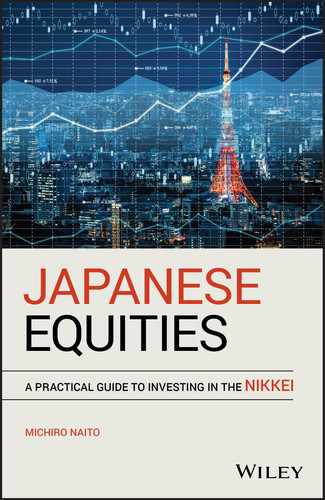Epilogue
In writing this book, my original intent was to create a book of history as well as case studies. I became aware midway, however, how in‐depth and far‐reaching the content would have to be to meet the original aim. My awareness aside, I did not have the luxury of writing forever, obviously, as the market changes and progresses every day. Investment reports are required to be timely as well as accurate, and books on investment should adhere to the same standards. In this sense, composing this book was a race against time.
While I was in the middle of writing this book, the Nikkei 225 rose 16 days in a row for the first time in history, renewing its 26‐year high. Because the climb might have been triggered by the landside LDP victory in the autumn election, the market could have been titled “Abenomics Market III.”
At the same time, the US equity market could not have been more robust, with the S&P 500 moving well beyond the Buffett Indicator of 1.0, possibly reaching a bubble‐like stratosphere. The record low interest rates worldwide and ample cash generated by easy money policies apparently continued to display a positive (if the market is a bubble, negative) impact on the overall economy.
The Goldilocks Market seemed to conjure a paradigm shift, and I found it ironic that the OECD CLI, whose effectiveness is the mainstay of this book, did not work well in the market environment for more than a year after August 2017.
The Japanese equity market in the second half of 2017 may be characterized by the aforementioned election victory by the LDP; recovery in the US and Chinese economy; the Fed‐BoJ policy rate differentials leading to the weaker‐JPY trend and its potential benefit for Japanese corporations, which also enjoyed record retained earnings; and the phenomenal strength of the US equity market likely induced by the prospect of the largest tax cuts in history. The market surge we saw in November 2017 was likely the seasonality effect alluded to earlier in this text. When the direction of the economy is not clear‐cut, often seasonality supersedes other factors.
I retired from the position of derivative strategist as of August 2017, but had I written a research report since, the tone undoubtedly would have been bullish after the landslide LDP election victory and would have continued to be so from seasonality and the passage of the US Tax Cuts and Jobs Act. This said, to be honest, I could not have guessed that the Nikkei 225 would reach a 26‐year high.
Leaping forward to February 2018, the Goldilocks Market scenario came under question due to the rise in the US long‐term interest rates. The equity market saw a major correction globally, only to be overshadowed by a far more serious correction in the last quarter of the year. As described in the text earlier, the culprit of the correction in the last quarter of 2018 was not only the long‐term interest rates but also the apparent materialization of the US‐China trade war.
In a sense, what may be called the “Trump factor” worked positively in 2017 but perhaps negatively in 2018. In fact, by the end of 2018, the TOPIX trade based on the OECD CLI would have generated a positive return for the 2017–2018 period.
This is the turn of events that prompted me to add the last chapter, titled “September 2017–December 2018,” to the original text. This last chapter, I hope, gives a more up‐to‐date view on some of the topics encompassed in the rest of the text, and also confirms many of the claims made in the earlier chapters of the book.
As repeated many times throughout this book, the market rules and patterns are what we saw in the past and may not pertain to future markets. In principle, the market will continue to be the mirror of the economy as well as of the human mind, but with the increased role of AI in the market, these principles seem by no means absolute. Historically, the market has experienced paradigm shifts many times, and each time, investors had to adjust methodologies or create new ones. As long as investors are guided by greed and fear, this pattern will perhaps never change.
Needless to say, I do not believe that this book has covered all methods and formulae required to generate profits from the Japanese equity market. Many phenomena and subjects are not discussed, and probably some backtests described are not thorough enough.
As stated in the beginning, the market suffers from a large quantity of noise, and this book was written with the intent of eliminating noise as much as possible, but then again, what I consider to be noise may turn out in future to be the sound we should listen to. On this point, I stand in the court of judgment, willing to receive any criticism and praise that come my way.
